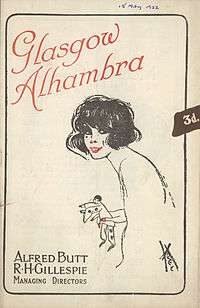Alhambra Theatre Glasgow
| Address |
Waterloo Street Glasgow |
|---|---|
| Owner |
Glasgow Alhambra Ltd (1910-1953) Howard & Wyndham Ltd (1953-1969) |
| Type | Proscenium |
| Capacity | 2,800 |
| Current use | Demolished 1971 |
| Construction | |
| Opened | 19 December 1910 |
| Closed | 24 May 1969 |
| Years active | 59 |
| Architect | John James Burnet |

The Alhambra Theatre, Glasgow opened on 19 December 1910 at the corner of Waterloo Street and Wellington Street, Glasgow under the direction of Sir Alfred Butt and was acknowledged as one of the best equipped theatres in Britain, planned to accommodate 2,800 people. .[1]
The theatre was designed by architect, Sir John James Burnet. It was built on the site of the popular Waterloo Rooms, which had previously been Wellington Street Church. The name derives from association with the Moorish palace in Granada, and was styled in "a cubic design with a colonnade of deep eaves, topped with twin oriental domes.
Its exterior was red brick banded with black and panels of white-glazed tile towards the top. Inside were canopies with sparing Louis XVI decoration." .[2] It was always regarded as a modern theatre and one of the No 1 theatres, known also as A1 theatres, of which by the 1960s there were only 14 remaining in Britain.
The theatre had a revolving stage, and from 1961 the stage was doubled in size to become the Starlight Room for the Five Past Eight shows.[3] Throughout most of its life the theatre was owned by Glasgow Alhambra Ltd. In the 1920s it formed an association with Moss Empires who bought 20% of the company shareholding.[4]
The Alhambra opened with Yvonne Guilbert from France and specialised in variety, including artistes from America, Australia and Continental Europe. Pantomimes began, using the Wylie-Tate production company. Scottish performers included Harry Lauder, Will Fyffe, Alec Finlay and Harry Gordon; revues and musical plays were added, featuring Cicely Courtneidge, Jack Buchanan, Evelyn Laye, Jessie Matthews and Ivor Novello; and also opera, ballet and dance. In 1941 it was the debut theatre of the International Ballet newly formed by Mona Inglesby.[5]
From the 1940s, the new Wilson Barrett Repertory Company, not the 19c company, made the Alhambra their largest base in Scotland.[6]
The theatre became a part of the Howard & Wyndham Ltd theatre company, in 1953, which purchased the theatre after selling its Theatre Royal, to Roy Thomson, founder of Scottish Television.[7] Their linked theatres throughout the United Kingdom shared production costs and permitted touring to Britain's major cities. Examples included, the fabulous Five-Past Eight (Summer shows) and Wish for Jamie pantomimes. These shows included early stars of the television era, such as: Rikki Fulton, Jimmy Logan, Stanley Baxter, Fay Lenore, Eve Boswell, Kenneth McKellar,[8] Max Bygraves and Frankie Vaughan.[9]
The theatre had the distinction of staging Scotland's first Royal Variety Performance on 3 July 1958, and the Scottish première of My Fair Lady in May 1964. Glasgow Scouts performed their first Gang Show here in 1936; and Marlene Dietrich performed at the Alhambra from 7–11 November 1966.
The theatre continued to be well attended but the company were selling off their theatres, and after the final show by Cilla Black on 24 May 1969, the theatre closed. It was demolished in 1971. The site is now occupied by an office block, Alhambra House.
References
- ↑ Alhambra Glasgow by Graeme Smith, published 2011 ISBN 978-0-9559420-1-3
- ↑ [Dictionary of Scottish Architects and RCAHMS].
- ↑ Scottish Screen Archive (Amateur film of Alladin).
- ↑ Alhambra Glasgow by Graeme Smith, published 2011 ISBN 978-0-9559420-1-3
- ↑ Alhambra Glasgow by Graeme Smith, published 2011 ISBN 978-0-9559420-1-3
- ↑ The Glasgow Story accessed 27 November 2006
- ↑ "The Theatre Royal:Entertaining a Nation" by Graeme Smith ISBN 978-0-9559420-0-6
- ↑ University of Glasgow, Special Collections accessed 27 November 2006
- ↑
Coordinates: 55°51′37″N 4°15′35″W / 55.86028°N 4.25972°W